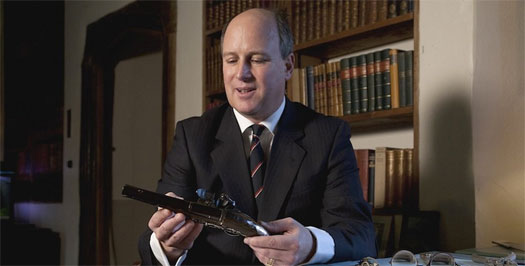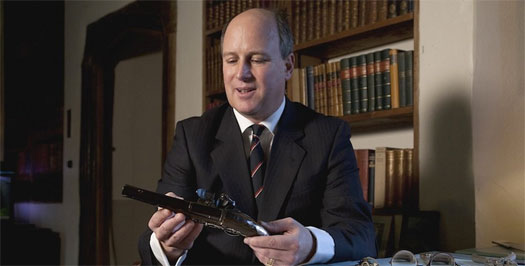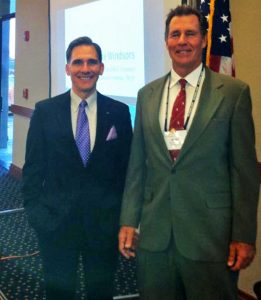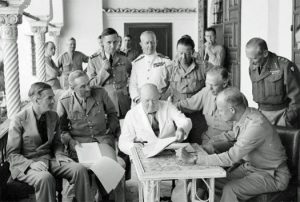
Bulletin #54 - Dec 2012
“The Making of Winston Churchill: A Transatlantic Tale of Two Families” at Chartwell

December 12, 2012
New exhibit, “In the Blood” to run through February 2013.  Randolph Churchill holds a dueling pistol of the 1st Duke of Marlborough
Randolph Churchill holds a dueling pistol of the 1st Duke of Marlborough
This winter sees the first-ever temporary exhibition at Chartwell, the former country home of Sir Winston Churchill in Kent. ‘In the Blood’, which opened to the public last month, explores Churchill’s Anglo-American ancestry and considers how the two branches of his family – the Jeromes of New York and the Marlboroughs of Blenheim – shaped his unique character and extraordinary life.
From the exotic tale of Churchill’s American grandmother Clarissa, who is thought to have had Iroquois Indian blood, to the battlefield heroics of John, 1st Duke of Marlborough, the story of Churchill’s ancestors is a fascinating and compelling blend of British tradition and New World adventure, energy and enterprise.
View a slide show on the exhibit at BBC.com
‘In the Blood’ shows how this transatlantic genetic inheritance helped create the great British wartime leader we know so well, a man with remarkable drive who was a prolific writer and accomplished painter as well as British Prime Minister twice. In a nod to the nature versus nurture debate, the display also takes visitors behind the scenes of Churchill’s childhood to reveal his touching relationship with his beloved nanny ‘Woomany’ as well as his complex relationships with his mother and father, Lord and Lady Randolph.

2024 International Churchill Conference
The story is told through a wide range of objects from the Chartwell stores and on loan from private collections belonging to Churchill’s descendants. Of the 50 objects, half have never been on public display before and have been brought together for this exhibition only.
Highlights include:
- A pair of duelling pistols and Garter Star belonging to Churchill’s 17th century ancestor John, 1st Duke of Marlborough, builder of Blenheim Palace [1]
- A charcoal drawing of Churchill’s glamorous Brooklyn-born mother Jennie Jerome by society artist John Singer Sargent [2]
- Diamond, ruby and sapphire rings given by Churchill’s father to his mother which have been reunited especially for this exhibition [3]
- A little-known portrait of Churchill’s grandmother Clarissa Jerome (neé Hall) [4]
- Portraits of the 1st Duke and Duchess of Marlborough (Kneller/school of Kneller) [5]
- Locks of children’s hair taken from Churchill and his brother Jack along with a photograph of their beloved nanny [6]
- Notes made by Churchill’s father Lord Randolph for the 1895 budget [7]
- Winston Churchill’s silver christening cup [8]
Randolph Churchill (pictured above), Winston’s great-grandson, said: “I am delighted to have been able to loan a number of family objects for display at Chartwell this winter. This exhibition shines a light on Winston’s parents and his forefathers who were so important in giving him the backbone he had in the dark days of 1940. Indeed he later wrote of that time: ‘I felt as if I were walking with destiny, and that all my past life had been but a preparation for this hour and for this trial.'”
Visit the Chartwell section of the National Trust website
Historian Professor Sir David Cannadine, said: “It is a timely innovation at Chartwell to begin holding and hosting exhibitions which help us to understand more fully the extraordinary range and richness of Churchill’s life. His Anglo-American ancestry was very important to him personally, and became very important to him politically. In the Blood helps us understand how and why this was so.”
When Lady Churchill handed Chartwell to the National Trust in 1965, many hundreds of personal family items were put into store. ‘In the Blood’ and future temporary exhibitions like it are designed to ensure the public can see as much of this reserve collection as possible alongside continued loans from the Churchill family. The exhibition is part of an ambitious plan to keep the grounds of Chartwell open 363 days a year, even when the house itself is closed for winter conservation and cleaning.
Alice Martin, House & Collections Manager at Chartwell and curator of ‘In the Blood’, said: “We are so pleased to have the opportunity to display these fantastic treasures over the winter here at Chartwell. I am personally very excited to see the fantastic oil paintings of Sir Winston’s grandparents and the beautiful engagement rings back together for perhaps the first time in over 100 years.”
The exhibition is open 11am to 4pm everyday (except Christmas Eve and Christmas Day) from Saturday 17 November until the end of February 2013. Tickets cost £6.50 for adults and include entry to the studio, which is home to the largest single collection of Churchill’s paintings, and to Chartwell’s stunning landscape and extensive gardens. The house itself is closed and will re-open in March 2013.
Chartwell is in Westerham, Kent.
Footnotes:
[1] Items belonging to John, 1st Duke of Marlborough (1650-1722)
Winston Churchill’s paternal ancestors rose from obscurity to prominence in the British aristocracy in the 17th century because of the qualities of one man; John Churchill. He was a key figure in the Glorious Revolution that secured the English throne for the Protestant cause and was recognised for his military genius by being made 1st Duke of Marlborough in 1702. His ebullient wife Sarah, Duchess of Marlborough, was a favourite of Queen Anne’s and was closely involved in the construction of Blenheim Palace, the Marlborough family seat. His Garter Star and duelling pistols are on display along with a portrait of him which hung in his descendant Winston’s bedroom at Chartwell.
[2] Drawing of Jennie Jerome
Churchill’s mother Jennie was born into a rich New York family in 1854 and had a privileged childhood of parties and foreign travel. Her father Leonard Jerome was known as the ‘King of Wall Street’ and was one time editor of the New York Times. As many American socialites would go on to do, Jennie and her sisters all married into prominent English families. Jennie had many admirers throughout her life and an impressive network of contacts which were to prove invaluable to both her husband, Lord Randolph Churchill, and her son Winston when he entered politics. This charcoal drawing by the American society painter John Singer Sargent captures Jennie’s style, beauty and intelligence. Winston worshipped his mother but she was a remote figure to him in childhood only gaining a closeness in later life. He later recalled:’ she shone for me like the evening star. I loved her dearly – but at a distance’.
[3] Rings
Winston’s father Lord Randolph gave his wife three rings (a diamond, a diamond and sapphire and a ruby and sapphire) during their marriage. Later in life Lady Randolph kept the diamond ring and gave the other two to her daughters-in-law, one of whom was Clementine, wife of Winston and the other to the wife of her son Jack. The rings have been loaned by the Churchill family and are reunited here for the first time in decades.
[4] Portrait of Clarissa Jerome (nee Hall)
Clarissa married Leonard Jerome in 1849 and her wealth set the Jerome family on the road to the great wealth it later enjoyed. It has been suggested that she had American-Indian blood and certainly this portrait shows a woman with dark colouring. Like many of his relatives, Winston Churchill believed this family legend though it has all but been disproved.
[5] (School of) Kneller portraits
These twin portraits of the 1st Duke and Duchess of Marlborough, the original ‘power couple’, have been loaned by the Churchill family. Sir Godfrey Kneller became Principal Painter to the Crown in 1680 and painted many leading figures and society beauties of the day.
[6] Woomany
Winston’s nanny Elizabeth Everest, whom he and his brother Jack nicknamed ‘Woomany’ or ‘Woomy’, made up to some extent for his mother Jennie’s remoteness in his early childhood. She was employed by Lord and Lady Randolph at Winston’s birth and would remain a constant affectionate presence throughout his childhood. When she died in 1895 Winston was at her side and paid for her headstone. He remarked at the time: ‘she had been my dearest and most intimate friend during the whole of the 20 years I had lived’.
[7] Lord Randolph
Winston’s relationship with his father was a difficult one and he once remarked: ‘a boy deprived of his father’s care often develops, if he escapes the perils of youth, an independence and vigour of thought which may restore in after life the heavy loss of early days’. Lord Randolph was the fifth child of the 7th Duke and Duchess of Marlborough and had a stellar early career in politics becoming Leader of the House of Commons and Chancellor of the Exchequer. He played a key role in the development of Tory Democracy. He was an intense figure who suffered from the same moods of black despair that would occasionally dog his son. He died at the age of just 46.
[7] Winston Churchill
Winston Churchill was born at Blenheim Palace in 1874. He surpassed all but a few of the great achievements of his ancestors but his transatlantic birthright was a key part of the story. In many ways a Renaissance man, he was a talented politician and military strategist, author and painter. His immense energy and breadth of interest was unusual for an Englishman of his time and was perhaps due in part to his American blood. His mother’s dynamism offset his father’s stiffness and reserve.
Photo: Copyright © BBC.
Subscribe
WANT MORE?
Get the Churchill Bulletin delivered to your inbox once a month.




